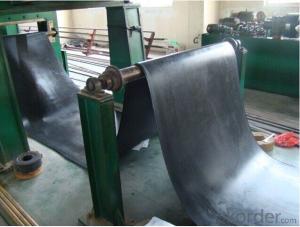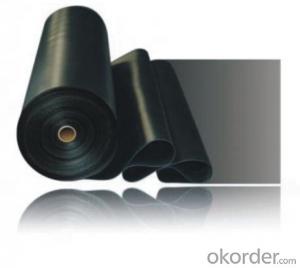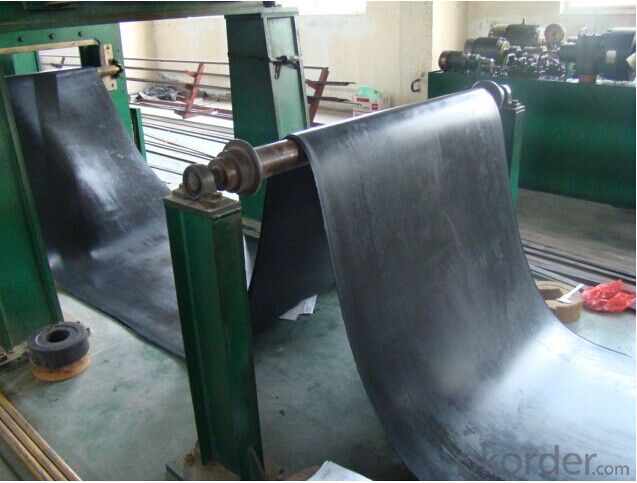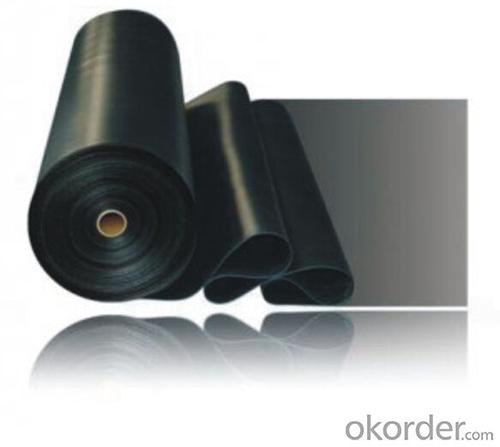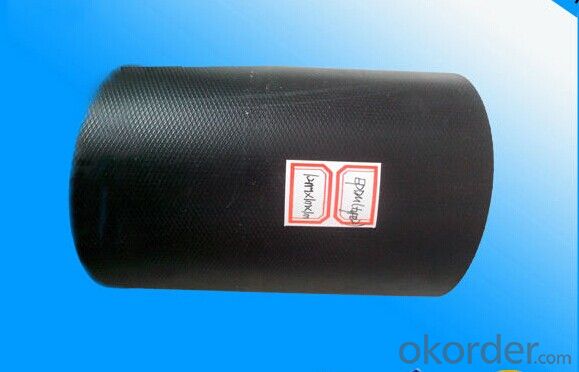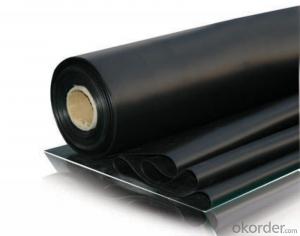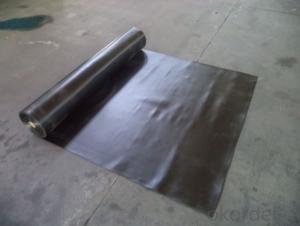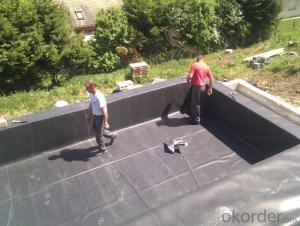Black EPDM Rubber Waterproof Swimming Pond Liner
- Loading Port:
- Qingdao
- Payment Terms:
- TT OR LC
- Min Order Qty:
- 2000 m²
- Supply Capability:
- 100000 m²/month
OKorder Service Pledge
OKorder Financial Service
You Might Also Like
EPDM waterproofing roofing membrane
1. Introduction:
1.Product composition
This waterproof coiled material is of high elasticity with best performance among high polumer
waterproof coiled material in the world.It is also the most typical one in the world.Waterproof
coiled material made of ternary ethylene-propylene rubber is produced withthe use of the most advanced contiuous extrusion and vulcanization technology and related
equipments which are specially designed for production of such product.It is good in compactness,
without bubble and performance difference in length and breadth,perfomances reach or exceed the demands of GB18173.1-2000 standard.
2. Advantages of epdm membrane
1>Excellent antiaging performance, service life up to 50 years
2>Working well with in 40C to 100C,it canbe constructed with a single layer in ambient temperature.
3>Waterproofing on various kinds of underground project,industrial of civil buildings and structures.
4>high extension rate, high tensile strength, small size changes at heat treatment
5>Good plant roots penetrability resistance and can be made waterproofing layer of planting roof
6>Special modified molecular structure ,effectively resolving the current domestic and foreign glue joint problem .
7>Good low temperature flexibility, and good performance of adapting to ambient temperature changes.
8>Convenient application ,solid joint, no environment pollution
9>chemical corrosion Resistance, can be used for special occasions
10>Convenient maitenance, low cost.
3. Application Scope of epdm membrane
Widely used in roofs, basement, toilet ,swimming pool, and all kinds of industry and civil building
waterproofing, reservoir, vivicism, bridge, underground, tunnel and dam waterproofing ,especially
to the keystone waterproofing projects which is durability, high corrosion resistance and easy
deformation.
4. Technical Data:
The item name | Indication | Applicable test items | ||||
Tension Strength (MPa) | Normal temperature≥ | 7.5 | GB6.3.2 | |||
60°C≥ | 2.3 | |||||
Elongation at break | Normal temperature≥ | 450 | ||||
-20°C | 200 | |||||
Tear strength N ≥ | 25 | GB6.3.3 | ||||
(0.3Mpa.30 min)Water tightness | No seeage | GB6.3.4 | ||||
Flexibility at low temperature ≤ | -40 | GB6.3.5 | ||||
Heat expansion (mm) | Extended ≤ | 2 | GB6.3.6 | |||
Contraction ≤ | 4 | |||||
(80°C×168h) | Fracture tensile strength retention %≥ | 80 | GB6.3.7 | |||
Hot air ageing | Keep rate tore elongation | 70 | ||||
%≥ | ||||||
Alkaline [10%Ca(OH)2Normal temperature×168h] | Fracture tensile strength retention %≥ | 80 | GB6.3.8 | |||
Keep rate tore elongation%≥ | 80 | |||||
Ozone aging | — | GB6.3.9 | ||||
Artificial climate ageing | Fracture tensile strength retention %≥ | 80 | GB6.3.10 | |||
Elongation at break %≥ | 70 | |||||
Bond peel strength | Standard test condition | 1.5 | GB6.3. | |||
4. Product Show:
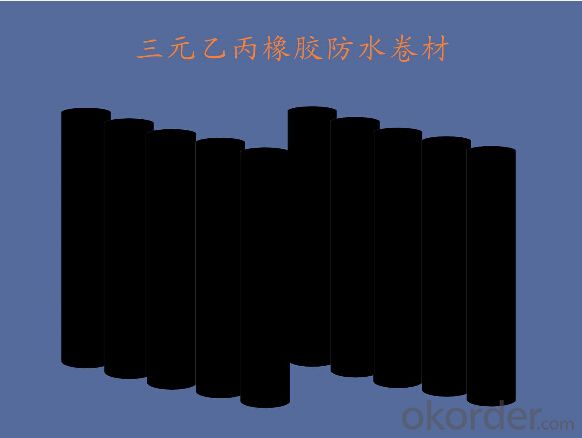
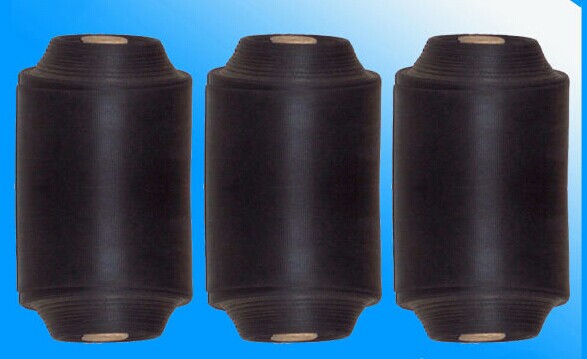
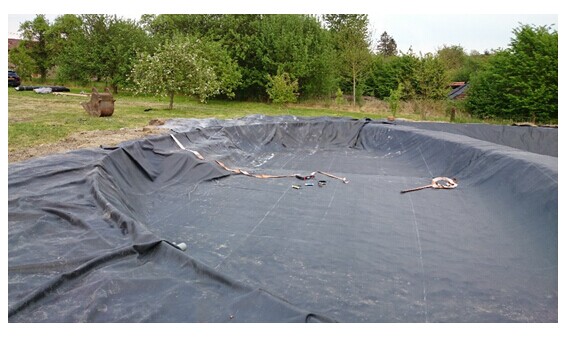
- Q: Can a waterproofing membrane be used in areas with extreme weather conditions?
- Indeed, in regions with severe weather conditions, one can employ a waterproofing membrane. Designed to safeguard against water infiltration, these membranes possess the ability to endure various climatic extremes, encompassing scorching heat, freezing cold, torrential downpours, and snowfall. Composed of sturdy materials, these membranes exhibit resistance to UV radiation, fluctuations in temperature, and other environmental elements. Furthermore, certain waterproofing membranes are specifically tailored for deployment in areas with harsh weather conditions, thereby bestowing superior performance and longevity. It is crucial to select a waterproofing membrane that aligns with the distinct weather conditions of the vicinity in order to guarantee enduring and effective protection.
- Q: Can waterproofing membranes be used on concrete tanks?
- Waterproofing membranes have the capability to be utilized on concrete tanks. These membranes are commonly employed in order to prevent water infiltration and safeguard concrete structures from water-related harm. Concrete tanks, much like other concrete structures, are vulnerable to water penetration over time, which can result in deterioration and structural problems. The application of a waterproofing membrane on the concrete surface can effectively obstruct water infiltration, thereby enhancing the tank's durability and prolonging its lifespan. A range of waterproofing membranes, including liquid-applied membranes, sheet membranes, and cementitious coatings, are available, each with its own unique advantages and suitability for different purposes. It is crucial to select the appropriate type of waterproofing membrane based on factors such as the tank's usage, exposure to water pressure, and environmental conditions. Additionally, proper surface preparation and application techniques play a significant role in ensuring the efficacy and longevity of the waterproofing membrane on the concrete tank.
- Q: Can a waterproofing membrane be installed on vertical surfaces without causing sagging or drooping?
- Yes, a waterproofing membrane can be installed on vertical surfaces without causing sagging or drooping. The key is to use a high-quality membrane that is specifically designed for vertical applications. These membranes are typically more rigid and have enhanced adhesion properties to ensure they stay in place, even on vertical surfaces. Additionally, proper installation techniques, such as correct surface preparation and ensuring good contact between the membrane and the substrate, are essential to prevent sagging or drooping.
- Q: Are waterproofing membranes easy to install?
- Yes, waterproofing membranes are generally easy to install. They come in various forms such as sheets, rolls, or liquid coatings, and can be applied using simple tools like brushes or rollers. Additionally, many membranes are self-adhesive, which further simplifies the installation process. However, it is important to follow the manufacturer's instructions and ensure proper surface preparation for optimal results.
- Q: Can a waterproofing membrane be used for a rooftop garden?
- Yes, a waterproofing membrane can be used for a rooftop garden. A waterproofing membrane is designed to prevent water from penetrating the surface it is applied to, making it an ideal solution for rooftop gardens where water can cause damage to the building structure. By installing a waterproofing membrane on the rooftop, it creates a barrier that prevents water from seeping through to the underlying layers, protecting the building from potential leaks and water damage. This is particularly important for rooftop gardens, as the weight of the soil and plants can increase the risk of water infiltration. Using a waterproofing membrane ensures that the rooftop garden remains structurally sound and free from any water-related issues.
- Q: Can a waterproofing membrane be used on precast concrete surfaces?
- Yes, a waterproofing membrane can be used on precast concrete surfaces. It helps to prevent water penetration and protect the concrete from moisture damage.
- Q: Can a waterproofing membrane be used in food processing or pharmaceutical facilities?
- Food processing and pharmaceutical facilities can make use of a waterproofing membrane. These facilities often rely on waterproofing membranes to keep the surroundings dry and prevent water damage. By creating a barrier against moisture, these membranes ensure that leaks and water penetration are avoided. This becomes particularly crucial in environments where hygiene and cleanliness are of utmost importance, like food processing and pharmaceutical facilities. Furthermore, these waterproofing membranes can be applied to floors, walls, and ceilings, guaranteeing comprehensive protection. They are also commonly made from materials that resist chemicals and bacteria growth, making them even more suitable for use in sensitive environments. Ultimately, incorporating a waterproofing membrane in food processing or pharmaceutical facilities proves to be an effective method of maintaining a dry and safe environment for the production of high-quality products.
- Q: Can a waterproofing membrane be used on both interior and exterior walls?
- Yes, a waterproofing membrane can be used on both interior and exterior walls. Waterproofing membranes are designed to prevent the penetration of water or moisture into the walls, regardless of whether they are located on the interior or exterior of a building. These membranes are typically made from materials such as rubber, modified bitumen, or liquid-applied coatings, and they provide an effective barrier against water infiltration. By applying a waterproofing membrane on both interior and exterior walls, you can ensure the long-term protection of your building from water damage, mold growth, and other moisture-related issues.
- Q: Can a waterproofing membrane be used on different types of surfaces, such as concrete, wood, or metal?
- Yes, a waterproofing membrane can be used on different types of surfaces such as concrete, wood, or metal. Waterproofing membranes are designed to create a barrier that prevents water from penetrating the surface and causing damage. They are versatile and can adhere to various materials, making them suitable for different applications. For concrete surfaces, a waterproofing membrane can be applied to protect against water intrusion and to prevent moisture-related issues such as cracks, corrosion, or mold growth. It can be used on concrete foundations, basements, or retaining walls to ensure they remain dry and structurally sound. When it comes to wood, a waterproofing membrane acts as a protective layer that prevents water absorption, warping, rotting, or decay. It can be applied to exterior surfaces like decks, balconies, or fences to enhance their lifespan and maintain their integrity. In the case of metal surfaces, a waterproofing membrane can be used to prevent rusting and corrosion caused by water exposure. It creates a barrier that seals out moisture, protecting metal roofs, gutters, or other metal structures from water damage. It is important to note that different types of waterproofing membranes may be more suitable for specific surfaces. For example, liquid-applied membranes can be easily applied on irregular surfaces like concrete, while sheet membranes may be more appropriate for flat or smooth surfaces. It is advisable to consult with a professional or manufacturer to determine the most suitable waterproofing membrane for a specific surface and application.
- Q: Can a waterproofing membrane be used in hospitals or healthcare facilities?
- Yes, a waterproofing membrane can be used in hospitals or healthcare facilities. In fact, it is highly recommended to use waterproofing membranes in these settings due to the critical need for maintaining a clean and hygienic environment. Waterproofing membranes are typically applied on floors, walls, and ceilings to prevent water or moisture infiltration, which can lead to mold growth, deterioration of building materials, and compromise the structural integrity of the facility. By using waterproofing membranes, healthcare facilities can effectively protect against water damage, facilitate easier cleaning and maintenance, and prevent the growth of bacteria and other harmful microorganisms. Additionally, waterproofing membranes can also help in managing moisture levels, thereby reducing the risk of slips and falls, which is especially crucial in areas where patients, staff, and visitors frequent. Overall, waterproofing membranes are a valuable asset in ensuring the safety, durability, and cleanliness of hospitals and healthcare facilities.
Send your message to us
Black EPDM Rubber Waterproof Swimming Pond Liner
- Loading Port:
- Qingdao
- Payment Terms:
- TT OR LC
- Min Order Qty:
- 2000 m²
- Supply Capability:
- 100000 m²/month
OKorder Service Pledge
OKorder Financial Service
Similar products
Hot products
Hot Searches
Related keywords
